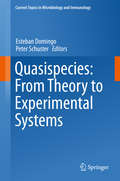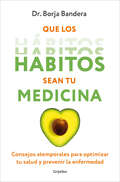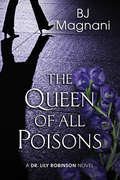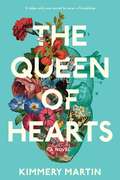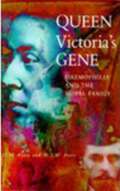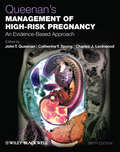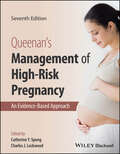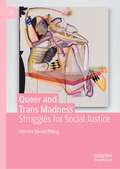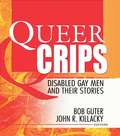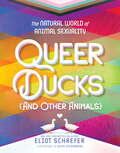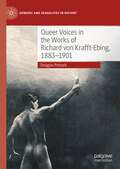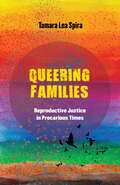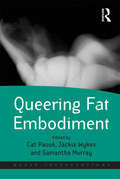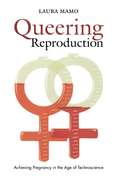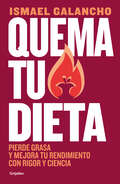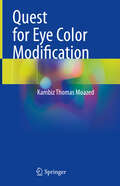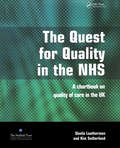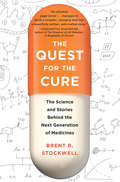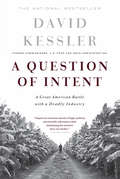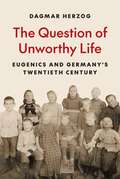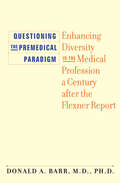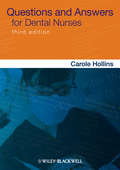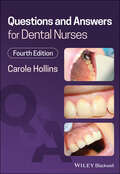- Table View
- List View
Quasispecies: From Theory to Experimental Systems
by Esteban Domingo Peter SchusterThis volume brings together recent developments in quasispecies theory extended to variable environments and practical applications in elucidating viral dynamics and treatment designs. In particular, the existence of an error threshold in rugged fitness landscapes has opened the way to a new antiviral strategy termed lethal mutagenesis, which is now under intensive theoretical, experimental and clinical investigation. As such the book explains how an understanding of quasispecies dynamics within infected organisms has increased our knowledge of viral disease events. From a clinical perspective, population dynamics highlights important problems for viral disease control, such as the selection of drug-resistant mutants that often accompanies treatment failures, and suggests means of increasing the effectiveness of antiviral treatments. The book is intended for students and scientists interested in basic and applied aspects of biophysics, chemistry, biology, evolution and medical virology.
Que los hábitos sean tu medicina: Consejos atemporales para optimizar tu salud y prevenir la enfermedad
by Borja Bandera Merchán«Borja tiene una manera de transmitir, compartir y hacer llegar su conocimiento y experiencia que me gusta: con respeto y humildad»Andrés Iniesta Claves sencillas para optimizar tu salud. Pequeños y poderosos cambios para prevenir la enfermedad y gozar de una longevidad saludable. Este libro actuará en ti como un catalizador que te animará a ponerte en acción para mejorar tu salud. Se trata de un ameno compendio de textos cortos que recoge los principales requisitos atemporales para optimizar tu salud. El doctor Borja Bandera aporta las herramientas necesarias para modificar tu conducta, te hace dueño de las decisiones que afectan a tu bienestar y te involucra en el proceso de recuperación: te empodera. Que los hábitos sean tu medicina, optimista, certero y lleno de energía positiva, ayuda a entender los atajos que conducen al cambio de hábitos para que cuidarte sea placentero. Y es que la soledad puede ser mucho peor que tener el colesterol alto, y la salud es mucho más que tomar medicamentos.
The Queen of All Poisons (The Dr. Lily Robinson Novels)
by BJ Magnani“Hidden under a cloak of legitimacy, I have been pressed to deliver extraordinary service for my country. It has been a successful ruse. A premium blend of dark deception with just an aroma of truth.” -Dr. Lily Robinson Dr. Lily Robinson is a brilliant physician with an encyclopedic knowledge of all toxins and poisons, and a penchant for stile os. In an unforeseeable twist in her life, the United States Government appeals to her patriotismand her knowledge of how to kill without bloodshedto rid the world of threats to our nation. Emotionally blunted and awed, she struggles to move between assassin and healer, yet still able to ful ll her competing objectives. Now asked to assassinate a terrorist threatening New York City, she quickly realizes the Russians have already released a deadly toxin in a surprisingly innocuous medium.
The Queen of Hearts
by Kimmery MartinA debut novel set against a background of hospital rounds and life-or-death decisions that pulses with humor and empathy and explores the heart's capacity for forgiveness...Zadie Anson and Emma Colley have been best friends since their early twenties, when they first began navigating serious romantic relationships amid the intensity of medical school. Now they're happily married wives and mothers with successful careers--Zadie as a pediatric cardiologist and Emma as a trauma surgeon. Their lives in Charlotte, North Carolina are chaotic but fulfilling, until the return of a former colleague unearths a secret one of them has been harboring for years. As chief resident, Nick Xenokostas was the center of Zadie's life--both professionally and personally--throughout a tragic chain of events in her third year of medical school that she has long since put behind her. Nick's unexpected reappearance during a time of new professional crisis shocks both women into a deeper look at the difficult choices they made at the beginning of their careers. As it becomes evident that Emma must have known more than she revealed about circumstances that nearly derailed both their lives, Zadie starts to question everything she thought she knew about her closest friend.
Queen Square: A History Of The National Hospital And Its Institute Of Neurology
by Simon Shorvon Alastair Compston Andrew Lees Michael J. Clark Martin RossorAs the first neurological hospital in the world, founded in 1859, the National Hospital, Queen Square, and its affiliated Institute of Neurology remain leading neurological centres providing exceptional clinical services, teaching and research. Illustrated by over 100 historical images and much unpublished archival material, this book provides a comprehensive history of the National Hospital, the Institute, and their staff. It relates the ups and downs of the Hospital and Institute in war and peacetime, their financial struggles, many personality conflicts, efforts to remain independent and to maintain neurological dominance, academic and clinical contributions, issues relating to specialisation and subspecialisation and relations between disciplines, and the changing roles of the Hospital and Institute. The history is told from varying perspectives against the backdrop of the evolution of British clinical neuroscience, the special position of London medicine, and the influence of world wars, and is set in the context of modern British social history.
Queen Victoria's Gene: Haemophilia and the Royal Family
by D M Potts W T W PottsQueen Victoria's son, Prince Leopold, died from haemophilia, but no member of the royal family before his generation had suffered from the condition. Medically, there are only two possibilities: either one of Victoria's parents had a 1 in 50,000 random mutation, or Victoria was the illegitimate child of a haemophiliac man. However the haemophilia gene arose, it had a profound effect on history. Two of Victoria's daughters were silent carriers who passed the disease to the Spanish and Russian royal families. The disease played a role in the origin of the Spanish Civil War; and the tsarina's concern over her only son's haemophilia led to the entry of Rasputin into the royal household, contributing directly to the Russian revolution.
Queenan's Management of High-Risk Pregnancy
by Charles J. Lockwood Catherine Y. Spong John T. QueenanFor the maternal-fetal physician, constant vigilance throughout a pregnancy remains essential. But continuous change makes this an increasing challenge. Queenan's Management of High-Risk Pregnancy covers the full spectrum of perinatal care. Providing evidence, algorithms, and case studies, this book guides you through the tough and complex decisions needed to protect the health of both your fetal and the maternal patients. New material in the 6th edition covers contemporary issues such as, iron-deficient anemia, malaria, pregnancy in the disabled woman, placenta accrete, induction of labor, operative vaginal delivery, and patient safety in labor and delivery. Written by experts in the field, no obstetrician or obstetric health care provider can afford to miss Queenan's Management of High-Risk Pregnancy.
Queenan's Management of High-Risk Pregnancy: An Evidence-Based Approach
by Catherine Y. Spong Charles J. LockwoodQueenan's Management of High-Risk Pregnancy The new edition of the long-standing classic text, covering all areas of perinatal medicine Continuing to set the standard for maternal-fetal practice, the seventh edition of Queenan's Management of High-Risk Pregnancy provides practical, clinically useful information on the full spectrum of perinatal care. Focused on clinical decision-making, this invaluable reference contains authoritative, evidence-based information on the factors of high-risk pregnancy, biochemical and biophysical monitoring, maternal disease, obstetric complications, patient safety in labor and delivery, and more. With more than 50 concise chapters, this text has been written by leading experts, and contains evidence-based protocols, algorithms, case studies, potential outcome measures, medications, and illustrative case reports to ensure the best possible outcomes for fetal and maternal patients. This text offers clear guidance on the common problems encountered in the day-to-day management of high-risk pregnancies. The seventh edition of Queenan's Management of High-Risk Pregnancy includes new and updated chapters with the most current evidence-based information and protocols available on topics such as infectious diseases in pregnancy, vaping, operative vaginal delivery, postpartum hemorrhage, pregnancies in women with disabilities, maternal anemia, malaria, and HIV infection. Queenan's Management of High-Risk Pregnancy: An Evidence-Based Approach, Seventh Edition, remains an indispensable reference and guide for obstetricians, gynecologists, OB/GYN trainees, midwives, and primary and general practitioners.
Queer and Trans Madness: Struggles for Social Justice
by Merrick Daniel PillingThis book urges those invested in social justice for 2SLGBTQ people to interrogate the biomedical model of mental illness beyond the diagnoses that specifically target gender and sexual dissidence. In this first comprehensive application of Mad Studies to queer and trans experiences of mental distress, Pilling advances a broad critique of the biomedical model of mental illness as it pertains to 2SLGBTQ people, arguing that Mad Studies is especially amenable to making sense of queer and trans madness. Based on empirical data from two qualitative research studies, this book includes analyses of inpatient chart documentation from a psychiatric hospital and interviews with those who have experienced distress. Using an intersectional lens, Pilling critically examines what constitutes mental health treatment and the impacts of medical strategies on mad queer and trans people. Ultimately, Queer and Trans Madness: Struggles for Social Justice explores the emancipatory promise of queer and trans madness, advocating for more resources to respond to crisis and distress in ways that are non-coercive, non-carceral, and honour autonomy as well as interdependence within 2SLGBTQ communities.
Queer Crips: Disabled Gay Men and Their Stories
by Bob Guter John R KillackyGet an inside perspective on life as a disabled gay man! Queer Crips: Disabled Gay Men and Their Stories reverberates with the sound of "cripgay" voices rising to be heard above the din of indifference and bias, oppression and ignorance. This unique collection of compelling first-person narratives is at once assertive, bold, and groundbreaking, filled with characters-and character. Through the intimacy of one-on-one storytelling, gay men with mobility and neuromuscular disorders, spinal cord injury, deafness, blindness, and AIDS, fight isolation from society-and each other-to establish a public identity and a common culture. Queer Crips features more than 30 first-hand accounts from a variety of perspectives, illuminating the reality of the everyday struggle disabled gay men face in a culture obsessed with conformist good looks. Themes include rejection, love, sex, dating rituals, gaycrip married life, and the profound difference between growing up queer and disabled, and suffering a life-altering injury or illness in adulthood. Co-edited by Bob Guter, creator and editor of the webzine BENT: A Journal of Cripgay Voices, the book includes: two performance pieces from acclaimed author and actor Greg Walloch poetry from Chris Hewitt, Joel S. Riche, Raymond Luczak, Mark Moody, and co-editor John Killacky essays from BENT contributors Blaine Waterman, Raymond J. Aguilera, Danny Kodmur, Thomas Metz, Max Verga, and Eli Clare interviews with community activist Gordon Elkins and Alan Sable, one of the first self-identified gay psychotherapists in the United States and much more! Queer Crips is a forum for neglected cripgay voices speaking words that are candid, edgy, bold, dreamy, challenging, and sexy. The book is essential reading for academics and students working in lesbian and gay studies, and disability studies, and for anyone who's ever visited the place where queerness and disability meet.
Queer Ducks (and Other Animals): The Natural World of Animal Sexuality
by Eliot SchreferThis groundbreaking illustrated YA nonfiction title from two-time National Book Award finalist and New York Times bestselling author Eliot Schrefer is a well-researched and teen-friendly exploration of the gamut of queer behaviors observed in animals.A quiet revolution has been underway in recent years, with study after study revealing substantial same-sex sexual behavior in animals. Join celebrated author Eliot Schrefer on an exploration of queer behavior in the animal world—from albatrosses to bonobos to clownfish to doodlebugs.In sharp and witty prose—aided by humorous comics from artist Jules Zuckerberg—Schrefer uses science, history, anthropology, and sociology to illustrate the diversity of sexual behavior in the animal world. Interviews with researchers in the field offer additional insights for readers and aspiring scientists.Queer behavior in animals is as diverse and complex—and as natural—as it is in our own species. It doesn’t set us apart from animals—it bonds us even closer to our animal selves.
Queer Voices in the Works of Richard von Krafft-Ebing, 1883–1901 (Genders and Sexualities in History)
by Douglas PretsellThis book is a critical edition of the autobiographical case studies used by the Austro-German psychiatrist Richard von Krafft-Ebing between 1883 and 1901. Forty-one individual case studies of same-sex attracted men and women, in their own words, made an eye-catching component of Krafft-Ebing’s most important work, PsychopathiaSexualis. Although the psychiatrist probably edited the autobiographical case studies, with the racier passages rendered in rather rudimentary Latin, what is particularly remarkable is that he preserved an unmistakeable queer discourse in some of the case studies that disputed the pathologising ideologies of the psychiatric texts in which they were embedded. Most of the autobiographies of same-sex attracted men follow the discursive patterns established in nineteenth-century psychiatry in providing descriptions of body features including genital size and shape, mental and physical health, family histories of health and disease, and accounts of life events from childhood to the present. This was because these men had been following Krafft-Ebing’s works and were now using their autobiographical contributions in Psychopathia Sexualis as a platform for negotiating the parameters of sexual orientation. Women’s sexuality was a relatively undeveloped component of Krafft-Ebing’s sexology but there are four case studies of women containing autobiographical content. Similarly, gender variance was hardly differentiated from sexuality at this period, but there are three autobiographies that clearly articulate cross gender identification, anticipating the future categories of transsexual and transgender. Krafft-Ebing reserved his therapeutic interventions to those individuals attracted to both sexes where hypnosis could supress same sex urges. Seven of these individuals supplied sexual autobiographies with two of them undergoing treatment as part of the overall case study. Together, these forty-one accounts give the reader a window into queer self-conceptions in Austria and Germany as the nineteenth century drew to a close.
Queering Families: Reproductive Justice in Precarious Times (Reproductive Justice: A New Vision for the 21st Century)
by Tamara Lea SpiraEnvisioning queer futures where we lovingly wager everything for the world’s children, the planet, and all living beings against all odds, and in increasingly precarious times. Queering Families traces the shifting dominant meanings of queer family from the late twentieth century to today. With this book, Tamara Lea Spira highlights the growing embrace of normative family structures by LGBTQ+ movements—calling into question how many queers, once deemed unfit to parent, have become contradictory agents within the US empire’s racial and colonial agendas. Simultaneously, Queering Families celebrates the rich history of queer reproductive justice, from the radical movements of the 1970s through the present, led by Black, decolonial, and queer of color feminist activists. Ultimately, Spira argues that queering reproductive justice impels us to build communities of care to cherish and uphold the lives of those who, defying normativity’s violent stranglehold, are deemed to be unworthy of life. She issues the call to lovingly wager a future for the world’s children, the planet, and all living beings against all odds, and in increasingly perilous times.
Queering Fat Embodiment (Queer Interventions)
by Samantha Murray Cat Pausé Jackie WykesCultural anxieties about fatness and the attendant stigmatisation of fat bodies, have lent a medical authority and cultural legitimacy to what can be described as ’fat-phobia’. Against the backdrop of the ever-growing medicalisation, pathologisation, and commodification of fatness, coupled with the moral panic over an alleged ’obesity epidemic’, this volume brings together the latest scholarship from various critical disciplines to challenge existing ideas of fat and fat embodiment. Shedding light on the ways in which fat embodiment is lived, experienced, regulated and (re)produced across a range of cultural sites and contexts, Queering Fat Embodiment destabilises established ideas about fat bodies, making explicit the intersectionality of fat identities and thereby countering the assertion that fat studies has in recent years reproduced a white, ableist, heteronormative subjectivity in its analyses. A critical queer examination on fatness, Queering Fat Embodiment will be of interest to scholars of cultural and queer theory, sociology and media studies, working on questions of embodiment, stigmatisation and gender and sexuality.
Queering Reproduction: Achieving Pregnancy in the Age of Technoscience
by Laura MamoOriginally developed to help heterosexual couples, fertility treatments such as in vitro fertilization and sperm donation have provided lesbians with new methods for achieving pregnancy during the past two decades. Queering Reproduction is an important sociological analysis of lesbians' use of these medical fertility treatments. Drawing on in-depth interviews with lesbians who have been or are seeking to become pregnant, Laura Mamo describes how reproduction has become an intensely medicalized process for lesbians, who are transformed into fertility patients not (or not only) because of their physical conditions but because of their sexual identities. Mamo argues that this medicalization of reproduction has begun to shape queer subjectivities in both productive and troubling ways, destabilizing the assumed link between heterosexuality and parenthood while also reinforcing traditional, heteronormative ideals about motherhood and the imperative to reproduce. Mamo provides an overview of a shift within some lesbian communities from low-tech methods of self-insemination to a reliance on outside medical intervention and fertility treatments. Reflecting on the issues facing lesbians who become parents through assisted reproductive technologies, Mamo explores questions about the legal rights of co-parents, concerns about the genetic risks of choosing an anonymous sperm donor, and the ways decisions to become parents affect sexual and political identities. In doing so, she investigates how lesbians navigate the medical system with its requisite range of fertility treatments, diagnostic categories, and treatment trajectories. Combining moving narratives and insightful analysis, Queering Reproduction reveals how medical technology reconfigures social formations, individual subjectivity, and notions of kinship.
Quema tu dieta: Pierde grasa y mejora tu rendimiento con rigor y ciencia
by Ismael GalanchoPierde grasa y gana salud con un método efectivo y riguroso basado en la alimentación flexible. ¿Por qué engordamos? ¿Por qué antes culpábamos a las grasas y ahora a los carbohidratos? ¿Por qué fracasan las dietas? ¿Por qué nos estancamos? Ismael Galancho desmitifica creencias sobre nutrición basadas en la cultura de la dieta y ofrece un plan para la pérdida de grasa que responde y se adapta a las necesidades individuales de cada cual, con objetivos factibles y mayor flexibilidad, frente a enfoques rígidos como la dieta cetogénica, la dieta paleo o el real food. Tras una larga trayectoria trabajando con deportistas de élite, Ismael demuestra que no existe una dieta válida para todos y para todo. La clave del éxito es diseñar un programa personalizado que te ayude a desarrollar hábitos duraderos y mantener así tus objetivos a largo plazo.Quema tu dieta fomenta una relación saludable con la comida y ofrece mayor libertad en la elección de alimentos. Con esta guía, la pérdida de peso se convertirá por fin en una meta alcanzable y, lo que es más importante, sostenible en el tiempo. Reseñas:«Con Ismael he aprendido muchísimo sobre nutrición, y eso para un jugador profesional es muy importante. Mis objetivos eran tener una alimentación sana y no perder masa muscular, y conseguí justo lo que quería. Ismael te hace ver cosas que uno solo no puede ver».Luis Suárez, jugador de fútbol profesional«Mi experiencia con Ismael fue un aprendizaje continuo. Mi meta era verme mejor físicamente, pero también llevar una alimentación más saludable y entender el significado de una buena nutrición. En su libro Quema tu dieta plasma de manera excelente su conocimiento y experiencia en este campo. Lo recomiendo al cien por cien».Antonela Roccuzzo, modelo y empresaria«En un mundo repleto de mensajes contradictorios y falsas creencias, Ismael nos ayuda a entender la realidad de la nutrición y el entrenamiento y, sobre todo, a aplicarla de manera práctica en la vida diaria. Con rigor, pero con sencillez».Marcos Vázquez, creador de Fitness Revolucionario«Una lectura amena y rigurosa. Vas a entender de una vez por todas que en nutrición no existen soluciones universales».Borja Bandera, médico especialista en Endocrinología y Nutrición «Como es habitual en él, Ismael logra traducir información científica a un idioma fácil y de aplicación inmediata. En este nuevo libro continúa con su obsesivo énfasis en comunicar conocimientos verificados en círculos académicos y probados en la práctica cotidiana. Una guía necesaria para todo aquel que ambicione optimizar su salud, su aspecto físico o su rendimiento deportivo».Francis Holways, nutricionista deportivo «Ismael ha conseguido algo realmente complicado con este libro: transmitir conocimientos científicos avanzados a la persona de a pie. Su trabajo en el campo de la nutrición, conocido por todo el mundo, es una fuente fiable de la cual aprender».Sergio Espinar, nutricionista deportivo «Basándose en evidencia científica, Ismael hace simple lo complejo y sorprende tras cada página devorada. Solo puedo añadir que ojalá hubiese llegado antes a mis manos, para recomedarlo a mis deportistas y pacientes como lectura obligatoria».Juanjo Moreno, preparador físico y fisioterapeuta de Carlos Alcaraz
Quest for Eye Color Modification
by Kambiz Thomas MoazedThis book examines the existing modalities of changing the color of the eye with their limitations. There has been no possible way to change the color of the eye with the “natural looking” result as of today. There have been many years of research and trials due to the immense public desire to be able to change the color of their eyes without success. From topical eye drops and colored contact lenses, to the more aggressive treatments such as laser ablation, corneal tattooing, or even iris implants, all have been tried and failed to achieve a “natural looking” result. This book explains the reason for the failure of each of these approaches without bias and discusses the advantages and disadvantages of each of these modalities. The book will cover the need for new approaches and new equipment and instruments that are necessary to achieve the goal of being able to modify the color of the eye to “look natural”. Chapters will also explore the scientific theoretical possibilities of achieving the task of eye color modification, in hope that future researchers have a blueprint for their studies and experiments to overcome this very difficult task
The Quest for Quality in the NHS: A Chartbook on Quality of Care in the UK
by Sheila Leatherman Kim SutherlandPUBLISHED IN ASSOCIATION WITH THE NUFFIELD TRUST Quality is an issue of central importance in the NHS and yet, despite a considerable number of initiatives, programmes and organisation that have focussed on improving quality in the NHS over recent years, there's no comprehensive, reliable balance and rigorous account of the strengths and weaknesses in healthcare delivery. This book provides an authoritative and accessible account of the state of quality in the NHS. Unless information on quality is properly gathered, organised, analysed and used, the health service will continue to lack a foundation on which sustained and systemic improvement can be based. The Quest for Quality in the NHS: a chartbook on quality of care in the UK is a comprehensive, rigorous and robust account of healthcare quality and will inform the public, managers, researchers and policymakers about gaps between what is possible, and what is delivered by the healthcare system.
The Quest for the Cure: The Science and Stories Behind the Next Generation of Medicines
by Brent StockwellAfter more than fifty years of blockbuster drug development, skeptics are beginning to fear we are reaching the end of drug discovery to combat major diseases. In this engaging book, Brent R. Stockwell, a leading researcher in the exciting new science of chemical biology, describes this dilemma and the powerful techniques that may bring drug research into the twenty-first century.Filled with absorbing stories of breakthroughs, this book begins with the scientific achievements of the twentieth century that led to today's drug innovations. We learn how the invention of mustard gas in World War I led to early anti-cancer agents and how the efforts to decode the human genome might lead to new approaches in drug design. Stockwell then turns to the seemingly incurable diseases we face today, such as Alzheimer's, many cancers, and others with no truly effective medicines, and details the cellular and molecular barriers thwarting scientists equipped with only the tools of traditional pharmaceutical research. Scientists such as Stockwell are now developing methods to combat these complexities-technologies for constructing and testing millions of drug candidates, sophisticated computational modeling, and entirely new classes of drug molecules-all with an eye toward solving the most profound mysteries of living systems and finding cures for intractable diseases. If successful, these methods will unlock a vast terrain of untapped drug targets that could lead to a bounty of breakthrough medicines. Offering a rare, behind-the-scenes look at this cutting-edge research, The Quest for the Cure tells a thrilling story of science, persistence, and the quest to develop a new generation of cures.
The Question of Competence: Reconsidering Medical Education in the Twenty-First Century
by Brian D. Hodges Lorelei Lingard M. Brownell AndersonMedical competence is a hot topic surrounded by much controversy about how to define competency, how to teach it, and how to measure it. While some debate the pros and cons of competence-based medical education and others explain how to achieve various competencies, the authors of the seven chapters in The Question of Competence offer something very different. They critique the very notion of competence itself and attend to how it has shaped what we pay attention to-and what we ignore-in the education and assessment of medical trainees.Two leading figures in the field of medical education, Brian D. Hodges and Lorelei Lingard, draw together colleagues from the United States, Canada, and the Netherlands to explore competency from different perspectives, in order to spark thoughtful discussion and debate on the subject. The critical analyses included in the book's chapters cover the role of emotion, the implications of teamwork, interprofessional frameworks, the construction of expertise, new directions for assessment, models of self-regulation, and the concept of mindful practice. The authors juxtapose the idea of competence with other highly valued ideas in medical education such as emotion, cognition and teamwork, drawing new insights about their intersections and implications for one another.
A Question Of Intent: A Great American Battle With A Deadly Industry
by David KesslerTobacco companies had been protecting their turf for decades. They had congressmen in their pocket. They had corrupt scientists who made excuses about nicotine, cancer and addiction. They had hordes of lawyers to threaten anyone-inside the industry or out-who posed a problem. They had a whole lot of money to spend. And they were good at getting people to do what they wanted them to do. After all, they had already convinced millions of Americans to take up an addictive, unhealthy, and potentially deadly habit. David Kessler didn't care about all that. In this book he tells for the first time the thrilling detective story of how the underdog FDA-while safeguarding the nation's food, drugs, and blood supply-finally decided to take on one of the world's most powerful opponents, and how it won. Like A Civil Action or And the Band Played On, A Question of Intent weaves together science, law, and fascinating characters to tell an important and often unexpectedly moving story. We follow Kessler's team of investigators as they race to find the clues that will allow the FDA to assert jurisdiction over cigarettes, while the tobacco companies and their lawyers fight back-hard. Full of insider information and drama, told with wit, and animated by its author's moral passion, A Question of Intent reads like a Grisham thriller, with one exception-everything in it is true.
The Question of Unworthy Life: Eugenics and Germany’s Twentieth Century
by Dagmar HerzogThe dark history of eugenic thought in Germany from the nineteenth century to today—and the courageous countervoicesBetween 1939 and 1945, Nazi genocide claimed the lives of nearly three hundred thousand people diagnosed with psychiatric illness or cognitive deficiencies. Not until the 1980s would these murders, as well as the coercive sterilizations of some four hundred thousand others classified as &“feeble-minded,&” be officially acknowledged as crimes at all. The Question of Unworthy Life charts this history from its origins in prewar debates about the value of disabled lives to our continuing efforts to unlearn eugenic thinking today.Drawing on a wealth of rare archival evidence, Dagmar Herzog sheds light on how Germany became the only modern state to implement a plan to eradicate cognitive impairment from the entire body politic. She traces how eugenics emerged from the flawed premise that intellectual deficiency was biologically hereditary, and how this crude explanatory framework diverted attention from the actual economic and clinical causes of disability. Herzog describes how the vilification of the disabled was dressed up as the latest science and reveals how Christian leaders and prominent educators were complicit in amplifying and legitimizing Nazi policies.Exposing the driving forces behind the Third Reich&’s first genocide and its persistent legacy today, The Question of Unworthy Life recovers the stories of the unsung advocates for disability rights who challenged the aggressive victimization of the disabled and developed alternative approaches to cognitive impairment based on ideals of equality, mutuality, and human possibility.
Questioning the Premedical Paradigm: Enhancing Diversity in the Medical Profession a Century after the Flexner Report
by Donald A. BarrThis book raises fundamental questions about the propriety of continuing to use a premedical curriculum developed more than a century ago to select students for training as future physicians for the twenty-first century. In it, Dr. Donald A. Barr examines the historical origins, evolution, and current state of premedical education in the United States. One hundred years ago, Abraham Flexner's report on Medical Education in the United States and Canada helped establish the modern paradigm of premedical and medical education. Barr’s research finds the system of premedical education that evolved to be a poor predictor of subsequent clinical competency and professional excellence, while simultaneously discouraging many students from underrepresented minority groups or economically disadvantaged backgrounds from pursuing a career as a physician. Analyzing more than fifty years of research, Barr shows that many of the best prospects are not being admitted to medical schools, with long-term adverse consequences for the U.S. medical profession. The root of the problem, Barr argues, is the premedical curriculum—which overemphasizes biology, chemistry, and physics by teaching them as separate, discrete subjects. In proposing a fundamental restructuring of premedical education, Barr makes the case for parallel tracks of undergraduate science education: one that would largely retain the current system; and a second that would integrate the life sciences in a problem-based, collaborative learning pedagogy. Barr argues that the new, integrated curriculum will encourage greater educational and social diversity among premedical candidates without weakening the quality of the education. He includes an evaluative research framework to judge the outcome of such a restructured system.This historical and cultural analysis of premedical education in the United States is the crucial first step in questioning the appropriateness of continuing a hundred-year-old, empirically dubious pedagogical model for the twenty-first century.
Questions and Answers for Dental Nurses
by Carole HollinsQuestions and Answers for Dental Nurses has been completely revised and updated for its third edition. Encompassing the significant changes to the NEBDN National Certificate, this book now includes both standard Multiple Choice Questions and the new style Extended Matching Questions with helpful explanatory information on responses. As a self-assessment tool this revision guide is a must-have for all trainee dental nurses looking to sit either the NEBDN examination or the NVQ in Oral Healthcare, up to level 3. Completely revised content and updated format The author is the current Chairman of the NEBDN and a member of its 'New Exam Project' Question Writing Team. 14 chapters in 4 sections covering the whole curriculum 2 types of multiple choice question throughout: 1 of 5 single best answer questions New scenario-based extended matching questions Clear explanation of answers Invaluable resource for independent revision Boosts confidence of readers preparing for examinations
Questions and Answers for Dental Nurses
by Carole HollinsQuestions and Answers for Dental Nurses An essential study aid for dental nursing students preparing for the NEBDN exam The newly revised Fourth Edition of Questions and Answers for Dental Nurses delivers a comprehensive and invaluable revision guide that covers the full curriculum of the National Examining Board for Dental Nurses (NEBDN) National Diploma in Dental Nursing. It is fully updated and incorporates recent developments in dentistry and changes to relevant legislation and regulation. The included questions mimic the style of questions used in the NEBDN examination and the accompanying answers and explanations discuss why a given answer is the best one. All four General Dental Council development outcomes—formerly called “domains”—are covered in the book, allowing students to gauge their progress and understanding on all of the areas they’ll be tested on. The book also includes: A thorough introduction to communication in dental nursing, including obtaining consents and record keeping, handling complaints, raising concerns and oral health instruction Comprehensive explorations of management and leadership, including chairside support, practice management, and health and safety Practical discussions of clinical considerations, including infection prevention and control, oral anatomy and physiology, dental pathology and microbiology, and assessment and diagnosis In-depth examinations of professionalism in the dental nursing context, including GDC standards, legal and ethical issues, and equality and diversity Questions and Answers for Dental Nurses 4th Edition is an essential resource for dental nurse students enrolled in the National Examining Board for Dental Nurses National Diploma training course, as well as dental tutors, trainers, and educators preparing candidates for this qualification.
